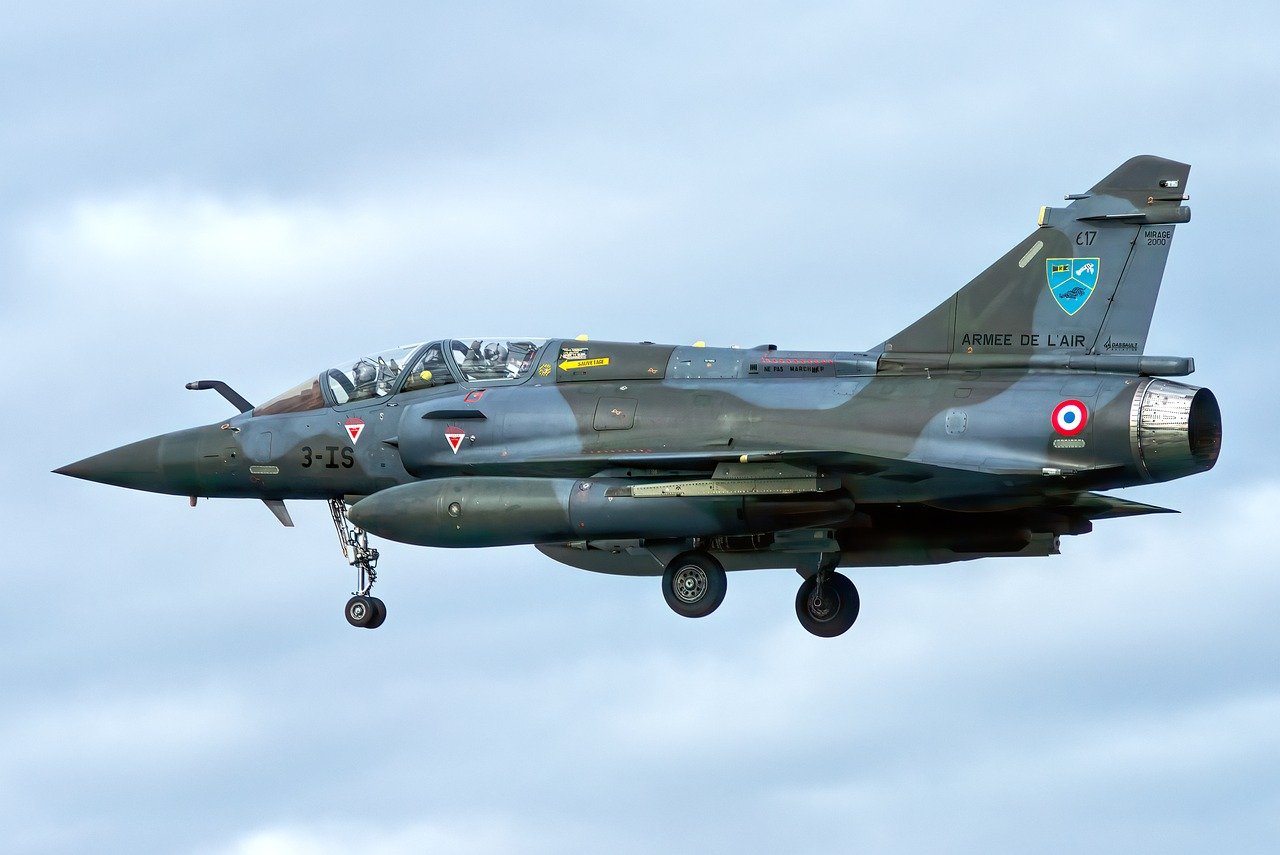The Role of Cloud Computing in Military Intelligence
In today's fast-paced world, the intersection of technology and defense has never been more crucial. Cloud computing has emerged as a game-changer for military intelligence, fundamentally transforming how defense organizations operate. Imagine a vast digital landscape where data is not just stored but analyzed, shared, and utilized in real-time. This evolution is akin to switching from a typewriter to a high-speed computer—suddenly, everything becomes faster, more efficient, and incredibly powerful.
Cloud computing enhances the capabilities of military intelligence by providing scalable storage solutions, enabling real-time data analysis, and fostering collaborative intelligence sharing. The ability to access and analyze vast amounts of data quickly and securely can mean the difference between success and failure in critical operations. As military forces face increasingly complex challenges, the need for innovative solutions has never been more pressing.
Moreover, cloud computing allows for seamless integration of advanced technologies such as machine learning and predictive analytics. These tools empower military personnel to anticipate enemy actions and make informed decisions based on comprehensive data analysis. In essence, cloud computing acts as the backbone of modern military intelligence, providing a framework that supports enhanced decision-making processes and operational efficiency.
As we delve deeper into the various aspects of cloud computing's role in military intelligence, we will explore how it revolutionizes data storage, analysis, and collaboration. By understanding these components, we can appreciate the profound impact that cloud technology has on safeguarding national security and enhancing military effectiveness.
- What is cloud computing in military intelligence?
Cloud computing refers to the use of internet-based storage and processing power to manage and analyze military data, improving efficiency and collaboration. - How does cloud computing enhance data security?
Cloud computing uses advanced encryption techniques and incident response strategies to protect sensitive military information from cyber threats. - Can cloud computing improve decision-making in military operations?
Yes, by providing real-time data analysis and predictive analytics, cloud computing enables military leaders to make informed decisions quickly. - What are the cost benefits of using cloud computing in the military?
Cloud computing reduces the need for physical infrastructure, allowing for optimized budgets and efficient resource allocation.

Enhanced Data Storage Solutions
In the fast-paced world of military operations, having access to vast amounts of data is crucial. Cloud computing provides scalable storage solutions that enable military organizations to securely store and manage this data. Imagine trying to find a needle in a haystack; without the right tools, it can be nearly impossible. Cloud storage acts as that tool, allowing military personnel to retrieve vital information quickly and efficiently. This means that when time is of the essence, they can access the intelligence they need without any hiccups.
One of the most remarkable features of cloud storage is its ability to scale. As military operations evolve, so do their data needs. With traditional storage solutions, expanding capacity often meant expensive hardware purchases and lengthy installation processes. In contrast, cloud computing allows for on-demand scalability. Military organizations can increase or decrease their storage capacity based on current mission requirements, ensuring that they always have the necessary resources at their fingertips. This flexibility is akin to having a toolbox that can expand or contract based on the job at hand.
Moreover, cloud storage enhances collaboration among different military branches. When data is stored in the cloud, it can be accessed by authorized personnel from various locations, fostering real-time collaboration. For instance, imagine a scenario where intelligence gathered by one unit is crucial for another unit's operations. With cloud storage, sharing this information becomes as simple as clicking a button. This immediate access to data not only improves operational efficiency but also enhances decision-making processes, allowing military leaders to act swiftly based on the most current information available.
Security is another critical aspect of cloud storage solutions. Military data is often sensitive and requires robust protection. Cloud providers implement advanced security measures, including encryption and access controls, to safeguard data from unauthorized access. This ensures that even when data is stored off-site, it remains protected against potential cyber threats. In this way, military organizations can focus on their missions without the constant worry of data breaches.
To summarize, the enhanced data storage solutions provided by cloud computing revolutionize military intelligence by offering:
- Scalability: Adjust storage capacity as needed.
- Accessibility: Retrieve data quickly from anywhere.
- Collaboration: Share intelligence seamlessly across units.
- Security: Protect sensitive information with advanced measures.
In conclusion, cloud computing not only simplifies data storage for military organizations but also enhances their operational capabilities. By leveraging these advanced solutions, military leaders can make informed decisions and respond to threats with unprecedented speed and efficiency.
- What is cloud computing in military intelligence? Cloud computing refers to the use of internet-based storage and processing to manage military data, allowing for enhanced collaboration and data management.
- How does cloud storage improve military operations? It offers scalable storage solutions, real-time data access, and enhanced security, which all contribute to improved decision-making and operational efficiency.
- Is military data safe in the cloud? Yes, cloud providers implement robust security protocols, including encryption and access controls, to protect sensitive military data.

Real-Time Data Analysis
In the fast-paced world of military operations, has become a game-changer. Imagine a battlefield where every second counts; being able to process and analyze data as it comes in can mean the difference between success and failure. Cloud computing provides military personnel with the tools they need to make quick decisions based on the most current information available. This capability not only enhances situational awareness but also empowers strategic planning in ways that were previously unimaginable.
With the integration of cloud-based analytics tools, military organizations can harness vast amounts of data from various sources, including satellite imagery, surveillance feeds, and intelligence reports. This information is then processed in real-time, allowing commanders to respond to emerging threats almost instantaneously. For example, consider a scenario where enemy movements are detected; having the ability to analyze this data in real-time enables military leaders to deploy resources effectively and adjust their strategies on the fly.
One of the most exciting aspects of real-time data analysis in military intelligence is the use of advanced machine learning algorithms. These algorithms are designed to sift through enormous datasets and identify patterns that might otherwise go unnoticed. By integrating machine learning with cloud computing, military analysts can predict enemy movements and behavior based on historical data. This predictive capability is invaluable; it allows for proactive measures rather than reactive ones, enhancing the overall effectiveness of military operations.
Utilizing predictive analytics enables military leaders to forecast potential scenarios based on real-time data. Imagine having a crystal ball that can project the outcomes of various tactical decisions. With cloud computing, this is becoming a reality. By analyzing trends and patterns, military strategists can make informed decisions that are backed by data-driven insights, significantly improving their operational effectiveness. For instance, if data suggests a high likelihood of an enemy attack in a specific area, resources can be redirected to bolster defenses in that location.
Additionally, cloud systems can automate the detection of potential threats by continuously analyzing incoming data streams. This automation significantly reduces response times to critical situations. Instead of relying solely on human intelligence, which can be prone to error and delay, automated systems can flag anomalies and suspicious activities in real-time. This capability is crucial for maintaining operational integrity and ensuring that military personnel can act swiftly when it matters most.
In summary, the role of real-time data analysis in military intelligence cannot be overstated. It not only enhances situational awareness but also allows for better resource allocation, strategic planning, and threat detection. As military operations continue to evolve, leveraging the power of cloud computing and real-time analytics will undoubtedly lead to improved decision-making and operational efficiency.
- What is real-time data analysis in military intelligence?
Real-time data analysis involves processing and analyzing data as it is collected, allowing military personnel to make quick, informed decisions based on the most current information available.
- How does cloud computing enhance data analysis?
Cloud computing provides scalable and efficient storage solutions, enabling military organizations to access and analyze vast amounts of data quickly, which is essential for timely decision-making.
- What role do machine learning algorithms play?
Machine learning algorithms help identify patterns in data that can predict enemy movements and behaviors, allowing military leaders to make proactive decisions based on data-driven insights.
- Can automated systems improve response times?
Yes, automated threat detection systems can continuously monitor data streams and flag anomalies, significantly reducing the time it takes to respond to potential threats.

Advanced Machine Learning Algorithms
In today's fast-paced military landscape, have emerged as a game-changer, transforming how military intelligence is gathered, analyzed, and utilized. These algorithms are not just about crunching numbers; they are about making sense of vast amounts of data in a way that was previously unimaginable. Imagine having a digital assistant that can sift through mountains of information, picking out the crucial bits that could mean the difference between success and failure on the battlefield. This is what machine learning brings to the table.
At the core of these algorithms is the ability to learn from data patterns. They can analyze historical intelligence reports, satellite imagery, and even social media feeds to identify trends and predict enemy movements. For instance, if a particular region sees an uptick in troop movements, the algorithm can flag this as a potential threat, allowing military leaders to respond proactively rather than reactively. This predictive capability is invaluable, as it enhances situation awareness and allows for more strategic planning.
Moreover, machine learning algorithms can operate in real-time, processing data as it comes in. This means that military personnel can receive alerts about emerging threats almost instantaneously. Consider the implications: a drone flying over hostile territory can analyze video feeds and detect unusual activity, sending alerts back to command centers within seconds. This rapid processing not only saves time but also significantly reduces the risk of human error, which can be critical in high-stakes scenarios.
Furthermore, the integration of machine learning with cloud computing creates a robust framework for military intelligence. The cloud provides the necessary computational power and storage capacity that these algorithms require. As military operations become increasingly data-driven, the synergy between machine learning and cloud technology will only grow stronger. Together, they can create a comprehensive intelligence system capable of adapting to new threats and challenges as they arise.
To illustrate the effectiveness of these algorithms, let’s look at a simple comparison of traditional intelligence analysis versus machine learning-enhanced analysis:
| Aspect | Traditional Analysis | Machine Learning Analysis |
|---|---|---|
| Data Processing Speed | Slow, manual analysis | Real-time processing |
| Data Volume | Limited by human capacity | Handles vast amounts of data |
| Predictive Capability | Reactive | Proactive |
| Error Rate | Higher due to human factors | Lower due to automation |
In conclusion, the integration of into military intelligence operations not only enhances data analysis but also revolutionizes the way military strategists think about threats and responses. As we continue to evolve in our technological capabilities, the potential for these algorithms will only expand, paving the way for smarter, more efficient military operations.
- What is machine learning in military intelligence? Machine learning in military intelligence involves using algorithms to analyze data patterns and predict potential threats, enhancing decision-making processes.
- How does cloud computing support machine learning? Cloud computing offers the computational power and storage needed for machine learning algorithms to process large datasets in real-time.
- Can machine learning reduce human error in military operations? Yes, by automating data analysis and threat detection, machine learning significantly reduces the likelihood of human error.
- What are some applications of machine learning in the military? Applications include predictive analytics for troop movements, automated threat detection, and real-time data analysis for improved situational awareness.

Predictive Analytics in Operations
Predictive analytics is like having a crystal ball for military operations, allowing leaders to foresee potential scenarios and make informed decisions. By analyzing historical data, military organizations can identify patterns and trends that help forecast future events. This is particularly vital in defense strategies, where the ability to anticipate enemy movements or potential threats can mean the difference between success and failure on the battlefield. Imagine a chess game where you can predict your opponent's next move; that's the power predictive analytics brings to military intelligence.
At its core, predictive analytics uses advanced algorithms and statistical models to sift through vast amounts of data. By leveraging cloud computing, military personnel can access these sophisticated tools in real-time, enabling them to respond swiftly to emerging situations. For instance, if data indicates an unusual buildup of enemy forces in a specific area, predictive analytics can help military leaders assess the likelihood of an imminent attack, allowing them to deploy resources more effectively.
The integration of predictive analytics into military operations doesn't just enhance decision-making; it also streamlines resource allocation. When military leaders can predict where their assets will be most needed, they can allocate personnel, equipment, and supplies more efficiently. This proactive approach reduces waste and ensures that every resource is utilized to its fullest potential. For example, if analytics suggest a high probability of conflict in a certain region, commanders can pre-position troops and equipment, ready to respond at a moment's notice.
Moreover, predictive analytics can also enhance training and preparedness. By simulating various scenarios based on predictive models, military organizations can conduct more effective training exercises. This not only prepares personnel for potential real-world situations but also helps in refining strategies and tactics. The insights gained from these simulations can be invaluable, providing a competitive edge that traditional methods simply cannot match.
In summary, predictive analytics in operations is revolutionizing how military intelligence is approached. It empowers leaders with the foresight needed to navigate complex and dynamic environments, ensuring that they are always one step ahead. As technology continues to evolve, the potential for predictive analytics to enhance military operations will only grow, making it an indispensable tool in the arsenal of modern defense strategies.
- What is predictive analytics in military operations?
Predictive analytics involves using statistical algorithms and machine learning techniques to analyze historical data and predict future outcomes, helping military leaders make informed decisions. - How does cloud computing enhance predictive analytics?
Cloud computing provides the necessary infrastructure to process and analyze vast amounts of data in real-time, making it easier for military organizations to leverage predictive analytics effectively. - Can predictive analytics improve resource management?
Yes, by predicting where resources will be needed most, military organizations can allocate personnel and equipment more efficiently, reducing waste and enhancing operational effectiveness. - What role does training play in predictive analytics?
Predictive analytics can be used to simulate various scenarios for training purposes, helping military personnel prepare for potential situations they may encounter in the field.

Automated Threat Detection
In the fast-paced world of military operations, timely responses to potential threats can make all the difference between success and failure. Automated threat detection systems, powered by cloud computing, have emerged as a game changer in this arena. Imagine having a vigilant assistant that never sleeps, continuously monitoring vast streams of data for any signs of danger. This is precisely what cloud-based systems offer, enabling military personnel to focus on strategy and execution rather than getting bogged down in data overload.
These systems utilize advanced algorithms that sift through enormous amounts of information, identifying anomalies that could indicate a security breach or an impending attack. Think of it as having a digital watchdog that alerts you at the first sign of trouble, allowing you to act swiftly. By leveraging machine learning, these automated systems become increasingly adept at recognizing patterns and predicting threats, which significantly enhances the overall security posture of military operations.
One of the standout features of automated threat detection is its ability to operate in real-time. This means that as new data flows in—whether from surveillance feeds, intelligence reports, or battlefield communications—the system is constantly analyzing and evaluating the information. For example, if a suspicious drone is detected in a restricted airspace, the system can immediately flag this as a potential threat and notify the appropriate personnel. This rapid identification is crucial in situations where every second counts.
Moreover, the integration of these systems with cloud infrastructure allows for seamless updates and improvements. As new threats emerge, the algorithms can be refined and enhanced without the need for complex installations or downtime. This flexibility ensures that military forces are always equipped with the most current tools to combat evolving threats.
To illustrate the impact of automated threat detection, consider the following table that outlines key benefits:
| Benefit | Description |
|---|---|
| Speed | Real-time analysis allows for immediate identification of potential threats. |
| Accuracy | Machine learning algorithms improve over time, reducing false positives. |
| Scalability | Cloud infrastructure can easily scale to accommodate increasing data volumes. |
| Cost Efficiency | Reduces the need for extensive physical security infrastructure. |
In conclusion, automated threat detection represents a significant leap forward in military intelligence capabilities. By harnessing the power of cloud computing, military organizations can not only enhance their operational efficiency but also ensure a proactive approach to security. The future of military operations is undoubtedly intertwined with these advanced technologies, paving the way for a more secure and responsive defense strategy.
- What is automated threat detection? Automated threat detection refers to systems that use algorithms to continuously monitor data for signs of potential security threats.
- How does cloud computing enhance threat detection? Cloud computing provides the necessary infrastructure for real-time data processing, enabling faster and more efficient threat identification.
- What are the benefits of automated threat detection in military operations? Key benefits include speed, accuracy, scalability, and cost efficiency, all of which contribute to improved security measures.
- Can these systems adapt to new threats? Yes, automated threat detection systems can be updated and improved continuously, allowing them to adapt to evolving security challenges.

Collaborative Intelligence Sharing
This article explores how cloud computing revolutionizes military intelligence by enhancing data storage, analysis, and collaboration, ultimately improving decision-making and operational efficiency in defense strategies.
Cloud computing provides scalable storage solutions that allow military organizations to store vast amounts of data securely, ensuring easy access and retrieval for timely intelligence operations.
With cloud-based analytics tools, military personnel can process and analyze data in real-time, enabling quicker responses to emerging threats and enhancing situational awareness on the battlefield.
Integrating machine learning with cloud computing allows for the development of sophisticated algorithms that can predict enemy movements and analyze patterns in intelligence data.
Predictive analytics can enhance strategic planning by forecasting potential scenarios, helping military leaders make informed decisions based on data-driven insights.
Cloud systems can automate the detection of potential threats by continuously analyzing incoming data streams, significantly reducing response times to critical situations.
In today's complex battlefield, is more crucial than ever. Cloud computing serves as a vital backbone for this collaboration, enabling military branches and allied forces to work together seamlessly. Imagine a scenario where different units, each with their own data and intelligence, can connect and share insights in real-time. This not only enhances situational awareness but also fosters a culture of teamwork that is essential for success in modern warfare.
With cloud platforms, data can be shared effortlessly across various military divisions, breaking down traditional silos that often hinder effective communication. For instance, intelligence gathered by ground troops can be instantly relayed to air support units, allowing for coordinated actions that can significantly change the tide of operations. Furthermore, cloud computing allows for the integration of various data sources, such as satellite imagery, reconnaissance reports, and even social media feeds, creating a comprehensive picture of the battlefield.
The benefits of collaborative intelligence sharing include:
- Real-time updates: Immediate access to the latest information ensures that all units are on the same page, reducing the chances of miscommunication.
- Enhanced decision-making: By pooling intelligence, military leaders can make more informed decisions, leading to better operational outcomes.
- Joint training exercises: Cloud computing facilitates virtual training sessions where different branches can collaborate and prepare for joint missions.
Moreover, the cloud’s ability to support collaborative tools means that military personnel can engage in discussions, share documents, and analyze data together, regardless of their physical location. This flexibility is particularly beneficial in joint operations with allied forces, where the need for synchronized actions is paramount. By leveraging cloud technology, military organizations can ensure that intelligence is not only shared but also acted upon swiftly, maximizing their operational effectiveness.
As military data moves to the cloud, robust cybersecurity protocols are essential to protect sensitive information from cyber threats and ensure operational integrity.
Utilizing advanced encryption techniques helps safeguard data during transmission and storage, ensuring that only authorized personnel can access classified information.
Cloud-based incident response strategies allow for rapid identification and remediation of security breaches, minimizing potential damage to military operations.
Cloud computing offers cost-effective solutions for military intelligence operations by reducing the need for physical infrastructure and enabling efficient resource allocation.
By leveraging cloud services, military organizations can optimize their budgets, allowing for reallocation of funds towards critical intelligence initiatives and technologies.
The scalability of cloud resources ensures that military intelligence can expand or contract capabilities based on mission requirements, providing flexibility in resource management.
Cloud computing in military intelligence refers to the use of cloud-based technologies to enhance data storage, analysis, and sharing among military organizations, improving overall operational efficiency.
By providing real-time data analysis and collaborative sharing capabilities, cloud computing enables military leaders to make informed decisions quickly, which is crucial in dynamic operational environments.
Military cloud systems employ advanced encryption techniques, incident response strategies, and continuous monitoring to protect sensitive data from cyber threats.
Yes, cloud computing can significantly reduce operational costs by minimizing the need for physical infrastructure and allowing for better resource management.

Improved Cybersecurity Measures
As military operations increasingly rely on cloud computing, the importance of robust cybersecurity measures cannot be overstated. The transition to the cloud presents unique challenges, particularly concerning the protection of sensitive data from malicious cyber threats. Military organizations must adopt comprehensive strategies to ensure that their operations remain secure and effective.
One of the primary concerns in cloud computing is the potential for unauthorized access to classified information. To combat this, military organizations are implementing advanced encryption techniques. These techniques not only protect data during transmission but also secure it while at rest. By encrypting sensitive information, even if a data breach occurs, the information remains inaccessible to unauthorized users. This layered approach to security is critical in maintaining operational integrity.
Another vital aspect of improved cybersecurity is the development of incident response strategies. In the event of a security breach, having a well-defined incident response plan is essential for minimizing damage and restoring operations swiftly. Cloud-based incident response strategies allow military personnel to quickly identify and remediate security threats, ensuring that any potential disruption to military operations is addressed immediately. The speed and efficiency of these strategies can be the difference between a minor incident and a significant operational setback.
To illustrate the importance of these measures, consider the following table that outlines key components of effective cybersecurity in military cloud operations:
| Cybersecurity Component | Description |
|---|---|
| Encryption | Protects data by converting it into a secure format that can only be read by authorized users. |
| Access Control | Ensures that only authorized personnel can access sensitive information, reducing the risk of insider threats. |
| Incident Response | A structured approach to managing the aftermath of a security breach or cyberattack, minimizing impact and restoring operations. |
| Continuous Monitoring | Involves ongoing surveillance of systems to detect and respond to potential threats in real-time. |
Alongside these measures, continuous training and awareness programs for military personnel are essential. Educating staff about the latest cybersecurity threats and best practices can significantly reduce the risk of human error, which often leads to security breaches. By fostering a culture of cybersecurity awareness, military organizations can empower their personnel to be the first line of defense against cyber threats.
In conclusion, as military intelligence operations become more reliant on cloud computing, the implementation of improved cybersecurity measures is not just beneficial but essential. By focusing on encryption, incident response strategies, and personnel training, military organizations can safeguard their sensitive data and maintain operational integrity in an increasingly digital battlefield.
- What is cloud computing in military intelligence? Cloud computing in military intelligence refers to the use of cloud-based technologies to store, analyze, and share intelligence data efficiently and securely.
- How does encryption enhance cybersecurity? Encryption transforms sensitive data into a secure format that can only be accessed by authorized personnel, protecting it from unauthorized access during transmission and storage.
- What are incident response strategies? Incident response strategies are structured plans designed to identify, manage, and mitigate the impact of cybersecurity incidents, ensuring quick recovery and minimal disruption to operations.
- Why is personnel training important in cybersecurity? Continuous training helps military personnel stay informed about the latest threats and best practices, reducing the likelihood of human error and enhancing overall security.

Encryption Techniques
In the realm of military intelligence, where data integrity and confidentiality are paramount, play a crucial role in safeguarding sensitive information. As military operations increasingly rely on cloud computing, the necessity for robust encryption methods has never been more critical. Imagine your most classified documents being sent over the internet without any protection—it's akin to leaving the front door of your home wide open while you're away. To prevent unauthorized access, military organizations employ a variety of encryption techniques that ensure data remains secure both during transmission and while at rest.
One of the most common methods is Advanced Encryption Standard (AES), which is widely recognized for its strength and efficiency. AES uses symmetric key encryption, meaning the same key is used for both encrypting and decrypting data. This technique is essential for maintaining the confidentiality of sensitive military communications. Another method is Transport Layer Security (TLS), which secures data sent over networks. TLS ensures that any information exchanged between military personnel and cloud services is encrypted, effectively creating a secure tunnel through which data can flow without the risk of interception.
Furthermore, military organizations often implement public key infrastructure (PKI) to manage digital certificates and public-key encryption. PKI allows for secure communications by enabling users to authenticate their identities through digital signatures. This is especially important in military settings, where verifying the identity of personnel can mean the difference between successful operations and catastrophic failures.
To illustrate the importance of these techniques, consider the following table that outlines various encryption methods and their applications in military intelligence:
| Encryption Method | Type | Application |
|---|---|---|
| AES | Symmetric | Data encryption for classified communications |
| TLS | Asymmetric | Securing data transmission over networks |
| PKI | Hybrid | Authentication and verification of personnel |
Moreover, military organizations are continually evolving their encryption strategies to stay ahead of potential threats. This includes the use of quantum encryption, which promises to revolutionize how data is protected. By utilizing the principles of quantum mechanics, this method ensures that any attempt to intercept or measure the data will alter its state, thereby alerting the parties involved. This level of security is particularly appealing in a military context, where the stakes are incredibly high.
In summary, encryption techniques are not just an added layer of security; they are fundamental to the integrity and success of military intelligence operations. By employing advanced methods like AES, TLS, and PKI, military organizations can effectively protect their data from cyber threats. As technology continues to evolve, so too will the strategies employed to secure sensitive information, ensuring that military operations remain efficient and secure in an increasingly digital world.
- What is the importance of encryption in military intelligence? Encryption is crucial for protecting sensitive data from unauthorized access, ensuring operational security and integrity.
- What are the most commonly used encryption methods? The most commonly used methods include AES, TLS, and PKI, each serving different purposes in data protection.
- How does quantum encryption differ from traditional methods? Quantum encryption uses the principles of quantum mechanics to secure data, making it nearly impossible to intercept without detection.

Incident Response Strategies
This article explores how cloud computing revolutionizes military intelligence by enhancing data storage, analysis, and collaboration, ultimately improving decision-making and operational efficiency in defense strategies.
Cloud computing provides scalable storage solutions that allow military organizations to store vast amounts of data securely, ensuring easy access and retrieval for timely intelligence operations.
With cloud-based analytics tools, military personnel can process and analyze data in real-time, enabling quicker responses to emerging threats and enhancing situational awareness on the battlefield.
Integrating machine learning with cloud computing allows for the development of sophisticated algorithms that can predict enemy movements and analyze patterns in intelligence data.
Predictive analytics can enhance strategic planning by forecasting potential scenarios, helping military leaders make informed decisions based on data-driven insights.
Cloud systems can automate the detection of potential threats by continuously analyzing incoming data streams, significantly reducing response times to critical situations.
Cloud computing facilitates seamless collaboration among military branches and allied forces, allowing for real-time sharing of intelligence and fostering joint operations.
As military data moves to the cloud, robust cybersecurity protocols are essential to protect sensitive information from cyber threats and ensure operational integrity.
Utilizing advanced encryption techniques helps safeguard data during transmission and storage, ensuring that only authorized personnel can access classified information.
In the fast-paced world of military operations, having a robust incident response strategy is not just beneficial—it's essential. When a cyber threat is detected, the speed and efficiency of the response can mean the difference between a minor inconvenience and a catastrophic breach. Cloud-based incident response strategies allow for rapid identification and remediation of security breaches, minimizing potential damage to military operations. By leveraging cloud capabilities, military organizations can implement automated monitoring systems that continuously assess network activity for unusual patterns or unauthorized access attempts.
One of the key components of an effective incident response strategy is the establishment of a well-defined incident response team (IRT). This team should be trained to act swiftly and decisively, equipped with the necessary tools and protocols to handle various types of incidents. The integration of cloud technology facilitates this by providing a centralized platform where information can be shared in real-time, allowing team members to collaborate efficiently.
Furthermore, cloud environments can support detailed incident tracking and reporting mechanisms. This enables military organizations to maintain a comprehensive log of incidents, which can be invaluable for forensic analysis and future prevention strategies. In addition, the use of cloud-based simulations can help prepare the IRT for potential incidents by allowing them to practice responses to various scenarios in a controlled environment.
To summarize, an effective incident response strategy in military intelligence must encompass:
- Automated monitoring systems for real-time threat detection.
- A well-trained incident response team capable of rapid action.
- Centralized communication platforms for efficient collaboration.
- Diligent tracking and reporting of incidents for future analysis.
- Simulation training to prepare for various incident scenarios.
Cloud computing offers cost-effective solutions for military intelligence operations by reducing the need for physical infrastructure and enabling efficient resource allocation.
By leveraging cloud services, military organizations can optimize their budgets, allowing for reallocation of funds towards critical intelligence initiatives and technologies.
The scalability of cloud resources ensures that military intelligence can expand or contract capabilities based on mission requirements, providing flexibility in resource management.
- What is cloud computing in military intelligence? Cloud computing refers to the use of remote servers hosted on the internet to store, manage, and process data, which enhances military operations by providing scalable resources and real-time data access.
- How does cloud computing improve data analysis in military operations? Cloud computing enables real-time data analysis, allowing military personnel to respond quickly to threats and improve situational awareness on the battlefield.
- What are the cybersecurity measures in cloud computing for military use? Cybersecurity measures include advanced encryption techniques, automated monitoring systems, and well-defined incident response strategies to protect sensitive military data.
- Can cloud computing reduce costs in military intelligence? Yes, cloud computing can significantly reduce costs by minimizing the need for physical infrastructure and enabling more efficient resource allocation.

Cost Efficiency and Resource Management
In the ever-evolving landscape of military operations, cost efficiency and effective resource management have become paramount. With the integration of cloud computing, military organizations can significantly reduce operational costs while enhancing their capabilities. Traditionally, maintaining vast physical infrastructure for data storage and processing has been a financial burden. However, cloud computing shifts this paradigm by providing a pay-as-you-go model, where military forces can access resources as needed without the overhead of maintaining expensive hardware.
This flexibility allows military leaders to allocate funds more strategically. Instead of pouring money into maintaining outdated systems, they can invest in cutting-edge technologies that enhance intelligence operations. For instance, cloud services allow for the rapid deployment of new applications and tools, which can be crucial during critical missions. By leveraging cloud solutions, military organizations can optimize their budgets, ensuring that every dollar spent contributes to their overall mission effectiveness.
Moreover, the scalability of cloud resources means that military intelligence can easily expand or contract its capabilities based on mission requirements. Imagine a scenario where a military unit is preparing for a large-scale operation. With cloud computing, they can instantly scale up their storage and processing power to handle the influx of data generated during the operation. Conversely, once the mission concludes, they can scale back down, ensuring that they only pay for what they use. This dynamic resource management is a game-changer in the realm of military logistics.
To illustrate the financial benefits of cloud computing, consider the following table that compares traditional IT infrastructure costs to cloud-based solutions:
| Cost Factors | Traditional IT Infrastructure | Cloud Computing |
|---|---|---|
| Initial Setup Costs | High | Low |
| Maintenance Costs | Ongoing | Minimal |
| Scalability | Limited | Highly Scalable |
| Resource Allocation | Fixed | Dynamic |
Additionally, cloud computing fosters better resource management through its centralized data access. Military personnel can retrieve and share intelligence from anywhere, ensuring that decision-makers have the most up-to-date information at their fingertips. This capability not only enhances operational efficiency but also improves collaboration among various branches of the military and allied forces.
In conclusion, the integration of cloud computing into military intelligence operations represents a significant advancement in cost efficiency and resource management. By embracing this technology, military organizations can not only save money but also enhance their operational capabilities, making them more agile and responsive to ever-changing threats.
- What are the primary benefits of cloud computing in military intelligence?
The primary benefits include improved cost efficiency, enhanced data storage and analysis, real-time collaboration, and robust cybersecurity measures.
- How does cloud computing enhance data security in military operations?
Cloud computing employs advanced encryption techniques and incident response strategies to protect sensitive data from cyber threats.
- Can cloud computing adapt to changing military needs?
Yes, cloud resources are highly scalable, allowing military organizations to expand or contract their capabilities based on mission requirements.
- What role does predictive analytics play in military intelligence?
Predictive analytics helps military leaders forecast potential scenarios, enabling data-driven decision-making and strategic planning.

Budget Optimization
This article explores how cloud computing revolutionizes military intelligence by enhancing data storage, analysis, and collaboration, ultimately improving decision-making and operational efficiency in defense strategies.
Cloud computing provides scalable storage solutions that allow military organizations to store vast amounts of data securely, ensuring easy access and retrieval for timely intelligence operations.
With cloud-based analytics tools, military personnel can process and analyze data in real-time, enabling quicker responses to emerging threats and enhancing situational awareness on the battlefield.
Integrating machine learning with cloud computing allows for the development of sophisticated algorithms that can predict enemy movements and analyze patterns in intelligence data.
Predictive analytics can enhance strategic planning by forecasting potential scenarios, helping military leaders make informed decisions based on data-driven insights.
Cloud systems can automate the detection of potential threats by continuously analyzing incoming data streams, significantly reducing response times to critical situations.
Cloud computing facilitates seamless collaboration among military branches and allied forces, allowing for real-time sharing of intelligence and fostering joint operations.
As military data moves to the cloud, robust cybersecurity protocols are essential to protect sensitive information from cyber threats and ensure operational integrity.
Utilizing advanced encryption techniques helps safeguard data during transmission and storage, ensuring that only authorized personnel can access classified information.
Cloud-based incident response strategies allow for rapid identification and remediation of security breaches, minimizing potential damage to military operations.
Cloud computing offers cost-effective solutions for military intelligence operations by reducing the need for physical infrastructure and enabling efficient resource allocation.
In the realm of military intelligence, budget optimization is not just a luxury; it’s a necessity. By leveraging cloud services, military organizations can significantly streamline their financial resources. This means less spending on expensive physical infrastructure, which can be a drain on budgets. Instead, cloud solutions allow for the reallocation of funds towards critical intelligence initiatives and technologies that enhance operational capabilities.
For instance, consider the traditional costs associated with maintaining on-premises servers, including hardware purchases, maintenance, and energy consumption. By transitioning to cloud computing, these costs can be drastically reduced. The flexibility of cloud services means that military organizations can pay for only what they use, leading to a more efficient allocation of resources. This model not only helps in cutting costs but also ensures that funds are directed towards projects that yield the highest impact.
Moreover, budget optimization through cloud computing enables military leaders to invest in cutting-edge technologies such as artificial intelligence and advanced analytics, which are crucial for modern warfare. By prioritizing these investments, they can stay ahead of potential threats and enhance their strategic capabilities.
In summary, cloud computing is a game-changer for military budget management. It empowers organizations to be more agile, cost-effective, and responsive to the ever-evolving demands of national security.
- What are the main advantages of using cloud computing in military intelligence?
Cloud computing enhances data storage, real-time analysis, and collaborative efforts, leading to improved decision-making and operational efficiency. - How does cloud computing improve data security in military operations?
Cloud computing employs advanced encryption techniques and robust incident response strategies to protect sensitive information from cyber threats. - Can cloud computing help in reducing military operational costs?
Yes, by minimizing the need for physical infrastructure and allowing for efficient resource allocation, cloud computing can significantly reduce operational costs. - What role does machine learning play in military cloud computing?
Machine learning algorithms integrated with cloud computing can predict enemy movements and analyze intelligence data patterns, enhancing strategic planning.

Scalability of Resources
In the fast-paced world of military operations, the ability to rapidly adapt to changing circumstances is not just beneficial—it's essential. This is where the scalability of cloud resources comes into play. Imagine a military unit that can effortlessly scale its data storage and processing capabilities up or down, depending on the mission at hand. With cloud computing, this flexibility is not just a dream; it's a reality. Military intelligence can expand its resources when facing large-scale operations, such as natural disasters or significant combat engagements, and retract them during quieter periods, ensuring that resources are utilized efficiently.
One of the standout features of cloud computing is its ability to provide on-demand resources. For instance, if a military operation requires additional computational power for data analysis, cloud services can instantly allocate more resources without the need for physical hardware installations. This dynamic allocation means that military leaders can make informed decisions based on real-time data, enhancing their operational effectiveness. The ability to scale resources in real-time can be likened to a chameleon changing its colors to adapt to its environment—always ready to respond to the demands of the situation.
Moreover, the cost-effectiveness of scalable resources cannot be overstated. By using cloud services, military organizations can avoid the hefty expenses associated with maintaining large physical infrastructures. Instead, they can pay for what they use, which is particularly advantageous in times of budget constraints. This model allows for budget optimization, enabling funds to be redirected towards critical areas like advanced training or new technologies that enhance intelligence capabilities.
To illustrate the benefits of scalability in military intelligence, consider the following table that outlines key advantages and examples of scalable resources in action:
| Advantage | Example |
|---|---|
| On-Demand Resource Allocation | Instantly increase data processing power during a crisis. |
| Cost Efficiency | Pay only for the storage and processing power used. |
| Flexibility in Operations | Adjust resources based on mission requirements, such as scaling up for joint operations. |
In conclusion, the scalability of cloud resources is a game-changer for military intelligence. It not only enhances operational readiness but also ensures that resources are allocated efficiently, allowing military organizations to adapt swiftly to any situation. As we move forward into an era where data plays an increasingly pivotal role in defense strategies, embracing the scalability of cloud computing will undoubtedly be a cornerstone of effective military operations.
- What is cloud computing in military intelligence?
Cloud computing refers to the use of online services to store, manage, and process data, which enhances military intelligence operations by providing scalable and efficient solutions. - How does scalability benefit military operations?
Scalability allows military organizations to adjust their resources based on current needs, ensuring they can respond effectively to changing circumstances without unnecessary costs. - What are the cost benefits of using cloud computing?
Cloud computing reduces the need for physical infrastructure, allowing military organizations to pay only for the resources they use, which can lead to significant cost savings. - Can cloud computing improve collaboration among military branches?
Yes, cloud computing facilitates real-time sharing of intelligence and data, promoting better collaboration and joint operations among different military branches.
Frequently Asked Questions
- What is cloud computing in military intelligence?
Cloud computing in military intelligence refers to the use of cloud-based technologies to enhance data storage, analysis, and collaboration among military organizations. This technology allows for secure and scalable storage solutions, enabling timely access to vital intelligence data.
- How does cloud computing improve data analysis in the military?
Cloud computing enhances data analysis by providing real-time analytics tools that military personnel can use to process and analyze data quickly. This capability allows for faster responses to emerging threats and improves situational awareness on the battlefield.
- What role do machine learning algorithms play in military intelligence?
Machine learning algorithms integrated with cloud computing help predict enemy movements and analyze patterns in intelligence data. These sophisticated algorithms enhance decision-making by providing data-driven insights that inform strategic planning.
- What are predictive analytics and how are they used in military operations?
Predictive analytics involves using data to forecast potential scenarios, helping military leaders make informed decisions. By analyzing historical data and trends, predictive analytics can enhance strategic planning and operational efficiency in military missions.
- How does cloud computing facilitate collaboration among military branches?
Cloud computing enables seamless collaboration by allowing military branches and allied forces to share intelligence in real-time. This fosters joint operations and enhances the overall effectiveness of military strategies.
- What measures are in place to ensure cybersecurity in military cloud computing?
Robust cybersecurity protocols are essential in military cloud computing. These include advanced encryption techniques to protect sensitive data during transmission and storage, as well as incident response strategies to quickly address any security breaches.
- How does cloud computing contribute to cost efficiency in military intelligence?
Cloud computing reduces the need for physical infrastructure, which can be costly to maintain. By leveraging cloud services, military organizations can optimize their budgets and reallocate funds towards critical intelligence initiatives and technologies.
- What does scalability mean in the context of military cloud resources?
Scalability in military cloud resources refers to the ability to expand or contract capabilities based on mission requirements. This flexibility allows military intelligence operations to adapt to changing conditions and needs efficiently.



















